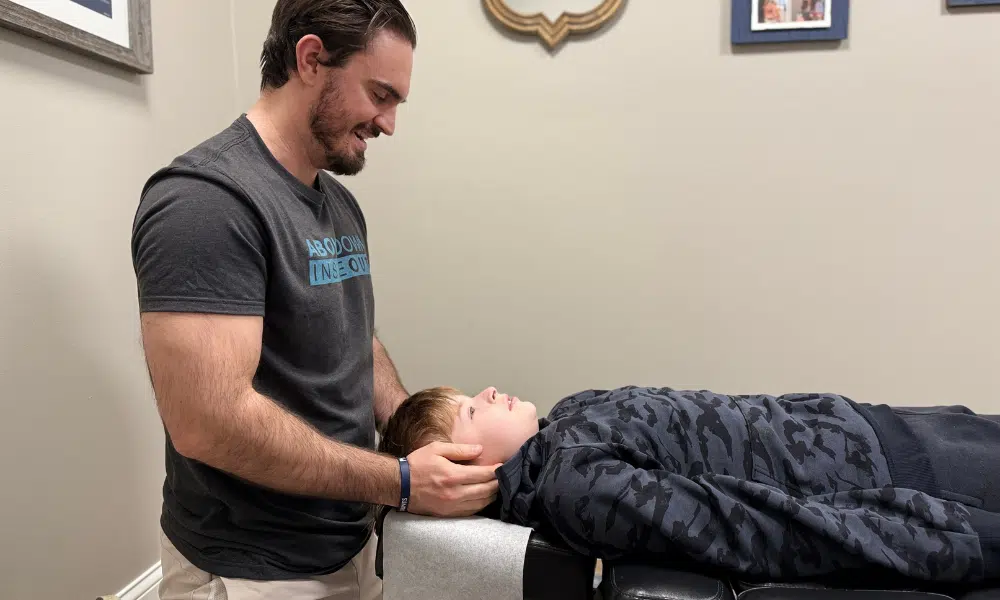Life today is increasingly filled with chronic stress. Between demanding jobs, financial worries, health conditions, relationship issues, and excess digital noise, many of us feel overwhelmed, on edge, depleted, and worn out. According to the American Institute of Stress, 94% of employees feel stressed.
When we’re constantly under pressure, whether from digital sources or real life, our body’s “fight or flight” response kicks in. This can lead to increased heart rate, faster breathing, tense muscles, and other bodily changes. The issue arises when this response doesn’t let up, and we lose access to the body’s “rest and digest” functions, leading to health problems over time.
The good news is that we have a built-in biological asset called the vagus nerve, which significantly promotes relaxation and overall well-being.
In this article, we’ll explore how simple techniques for vagus nerve stimulation at home, particularly when coupled with Neurologically-Focused Chiropractic Care, can effectively reduce the impact of chronic stress on our mind and body.
What is the Vagus Nerve, and Why is it So Important?
The vagus nerve is the longest and most expansive cranial nerve, running from the brainstem into the abdomen. This critical nerve communication system establishes an information superhighway between the brain and almost all major organs.
As the “wandering nerve,” its name in Latin, the vagus nerve helps coordinate optimal function for diverse processes like breathing, heart rate variability, digestive strength, inflammation regulation, mood stability, and numerous other major functions.
The vagus nerve comprises approximately 80% afferent fibers, meaning its primary function is to carry a continual stream of sensory signals like a highly sophisticated surveillance feed from the body’s organs and tissues back to various brain centers. This flow of peripheral neurological data allows the brain to perceive and integrate what’s happening throughout the body to fine-tune physiological responses appropriately.
One of the vagus nerve’s key response roles is to activate the parasympathetic “rest, restore, and nourish” functions that slow heart rate variability patterns into deeper coherence, promote digestion and absorption of nutrients, maintain tissue repair and maintenance, modulate elimination functions, and perhaps most pivotally, suppress runaway inflammation processes.
Optimized functioning here signifies the smooth integration of stress response capabilities with recovery, restoration, and growth processes—the hallmarks of resilience and adaptive capacity.
However, when the vagus nerve is somehow impaired or interfered with due to emotional or physical distress, poor diet quality, medications, and environmental toxicants, various aspects of our health can become suboptimal.
Some research suggests that those over age 55 begin to lose vagal capacity measurably. These issues open the door for emerging anxiety, headaches, gut disorders, stubborn extra weight around the midline, brain fog, immune vulnerability, and mood instability.
How Modern Life and “The Perfect Storm” of Factors Impact the Vagus Nerve
Emerging clinical research reveals the functioning of the vagus nerve and an intact, resilient parasympathetic response provide a “Rosetta Stone” to decode the origins of nearly all modern maladies, from depression and addiction to autoimmune and inflammatory conditions. Master clinicians and visionaries, like leading neurologist Dr. Datis Kharrazian and cellular detox expert Dr. Dietrich Klinghardt, have illuminated a common denominator involved in most chronic and degenerative conditions: vagus nerve dysfunction or sympathetic overdrive upstream.
“The Perfect Storm” analogy describes an interlocking set of lifestyle factors that have made elevated stress, suboptimal diet, toxicity exposure, and inflammation a new baseline for health, and, unfortunately, nervous system dysregulation, in the 21st century. This results in vagal capacity decreasing for many as the years advance.
Additionally, inquiries into adverse childhood experiences (ACEs) reveal those enduring more difficult emotional environments in early home life are statistically more likely to develop chronic health disorders later on—implying potential childhood origins for vagus nerve-related issues.
Vagus Nerve Dysfunction
Given the expansive reach of the vagus nerve throughout the body as a central switching station of data flow between the brain and organs, it’s no surprise that impaired functioning can contribute causal links in the development of various health conditions over time.
Known as vagal dysfunction or neurogenic inflammation in clinical circles, it can stem from multiple intersecting origins:
- Physical Trauma: Injuries during birth or from sports/accidents affect the delicate nerve communication
- Inflammation: Unchecked fires of chronic inflammation damage the nerve over time
- Toxins and Poor Diet: Chemical exposures/nutrient deficiency starve key tissues
- Medications: Antibiotics to SSRIs to anticholinergics inhibit nerve communication
- Infections: Post-viral issues that alter gut-brain communication
- Aging: Studies show the aging process impacts vagal tone and heart rate variability (HRV) over time
When the vagus nerve loses signal strength and vital physiological conductivity due to any of these origins, some of the first signs may appear as:
- Digestive disorders
- Low energy and brain fog
- Mood instability
- Cardiometabolic imbalance
Because the vagus nerve supplies most of the nerve fibers that comprise the parasympathetic division of the autonomic nervous system, it’s ability to trigger relaxation becomes compromised when impacted by stress, trauma, aging, or nervous system imbalance. This contributes to dysautonomia, mood disorders, inflammatory issues, and chronic disease.
Fortunately, natural stimulation of the vagus nerve through techniques like deep breathing, meditation, and lifestyle factors detailed here can restore parasympathetic tone and nervous system regulation, enabling the body to heal naturally.
How to Achieve Vagus Nerve Stimulation at Home
From deep vagal breathing to cold exposure, meditation to humor and laughter, there are natural ways we can gently stimulate the vagus nerve to ease anxiety and stress. Reflexology foot massages, chanting, and yoga can calm the vagus nerve. Seeking advanced care to release subluxations and neural interference also provides targeted clinical vagus nerve support.
Focused Deep Breathing Exercises
Also known as diaphragmatic pranayama, this ancient practice subtly shifts the body into rest, repair, and recharge mode when done for 5-10 minutes daily. Learn to exhale fully and eventually make the exhale longer than the inhale. This taps the brake on excessive sympathetic activation. Let the lower belly expand outward with full inhales.
Cold Thermogenesis Exposure
Splashing the central face/forehead and sides of the throat area with cold water for 30-60 seconds ignites an evolutionary signal to fortify vagal capacity and resilience. Start with small 10-second bursts. Alternate hot and cold showers also train vascular reactivity.
Meditation, Prayer, and Visualization
Experienced meditators display a “ceiling effect,” where aged cells and tissues shed up to 7-8 years of biological aging compared to non-meditators, as telomerase repairs DNA. Loving-kindness practices increase positive emotions and neurochemicals. Chanting “Om” also stimulates key vagal communication systems.
Laughing
Playful laughter stimulates the vagus nerve by activating throat muscles and the diaphragm while lowering stress hormone levels like cortisol and epinephrine. Seek out amusing stimuli often.
Reflexology Foot and Hand Massages
Ancient Chinese medicine maps reflex zones of the hands and feet that open blocked energy and neural communication. Rubbing the TH-5 point on the fleshy webbing between the thumb and forefinger activates vagal flow.
Benefits of Vagus Nerve Stimulation at Home
There are myriad evidence-based benefits linked to amplifying vagus nerve conductivity, voltage, and bidirectional communication capacity through targeted lifestyle re-patterning and clinical support:
- Systemic Inflammation Reduction: Vagal nerves send complex sensory data through communication channels dense with immune cells that suppress inflammation, strengthening conductivity correlates to systemic dampening of fires linked to nearly all chronic diseases.
- Enhanced Gut Health: Poor vagus function translates to up to 80%+ reduced muscular contractions essential for healthy digestion and elimination transit times. Stimulation releases key enzymes aiding absorption.
- Elevated Heart and Brain Coherence: As the vagus nerve translates between the brain and heart, optimizing flow correlates to higher cardiac output, increased cognitive speed and accuracy, and improved stress adaptation.
- Mood and Memory: With upstream reach into emotional and memory centers like the amygdala, hippocampus, and prefrontal cortex, tuned voltage powers neurotransmitter cascades, easing anxiety, emotional volatility, and cognitive lapses while renewing innate capacity to navigate life’s inevitable stressors and adversities.
- Addressing Treatment-Resistant Depression: Techniques that stimulate the vagus nerve activate parasympathetic relaxation communication and can ease depression symptoms in those not responding to medications or talk therapy. Optimizing vagal tone counters excessive inflammation and nourishes neurotransmitters like serotonin to provide a pathway to remission when other options fail.
Retune the Instrument of Your Life
With chronic stress, distraction, and dysfunction reaching epidemic proportions through a “Perfect Storm” of cultural currents, our nervous systems endure relentless demands taxing minds and bodies down to the cellular depths. This manifests as the chronic illnesses and conditions that plague many daily.
Whether through simple techniques for vagus nerve stimulation at home, Neurologically-Focused Chiropractic Care, or a combination of the two, rebalancing one’s nervous system and vagus nerve naturally is possible. However, true restoration calls for addressing the root issues rather than just symptom management.
Using our advanced scanning technology, INSiGHT Scans, our qualified PX Docs can precisely locate these areas of neural misalignment. Then, neurological adjustments release tension and restore the affected neural communication.
Impaired vagus nerve function is behind many challenges both adults and children face today. If your child is struggling with health challenges, use our PX Docs Directory to find a qualified pediatric chiropractor near you. Addressing the root cause and restoring nervous system regulation early is the best way to achieve optimum quality of life and health, now and in the future.






